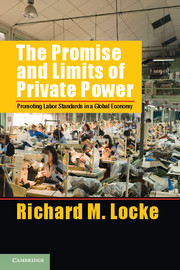Book contents
- Frontmatter
- Contents
- Acknowledgments
- 1 The Rise of Private Voluntary Regulation in a Global Economy
- 2 The Promise and Perils of Private Compliance Programs
- 3 Does Private Compliance Improve Labor Standards?
- 4 Capability Building and Its Limitations
- 5 Alternative Approaches to Capability Building
- 6 Are We Looking in The Wrong Place?
- 7 Complements or Substitutes?
- Conclusion
- Bibliography
- Index
- References
6 - Are We Looking in The Wrong Place?
Labor Standards and Upstream Business Practices in Global Supply Chains
Published online by Cambridge University Press: 05 May 2013
- Frontmatter
- Contents
- Acknowledgments
- 1 The Rise of Private Voluntary Regulation in a Global Economy
- 2 The Promise and Perils of Private Compliance Programs
- 3 Does Private Compliance Improve Labor Standards?
- 4 Capability Building and Its Limitations
- 5 Alternative Approaches to Capability Building
- 6 Are We Looking in The Wrong Place?
- 7 Complements or Substitutes?
- Conclusion
- Bibliography
- Index
- References
Summary
Introduction
As we saw in the previous chapters, notwithstanding years of investment in private compliance programs by global brands and their lead suppliers, and even after some more recent, promising capability-building initiatives by global corporations, multistakeholder initiatives, and international organizations, poor working conditions, excessive work hours, precarious employment practices, and low wages persist in factories producing for global supply chains. This chapter seeks to explain why some of these problems continue by looking beyond the suppliers’ factories and more broadly at the relationships among large retailers, global brands, lead suppliers, and factory workers in global supply chains. By taking this broader perspective, I hope to show that although better-designed private compliance systems and more encompassing capability-building programs would certainly help improve labor standards in these global supply chains, they are not in and of themselves sufficient to tackle these persistent workplace issues. This is because all of the interventions we have examined so far focus primarily on the locus of production, on the factories producing for global buyers. Although this focus on the workplace ostensibly makes sense given that this is where most labor standards violations are manifest, the reality is that many of the workplace problems we observe in global supply chains are not solely the product of poorly trained or unethical factory managers (hence in need of capability building or requiring careful auditing and policing) but also the result of a set of policies and practices designed and implemented upstream by large retailers and global buyers.
- Type
- Chapter
- Information
- The Promise and Limits of Private PowerPromoting Labor Standards in a Global Economy, pp. 126 - 155Publisher: Cambridge University PressPrint publication year: 2013

